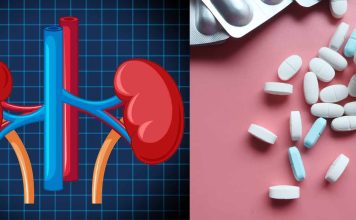Table of Contents
Breast Lift Overview
Breast lift is also recognized as mastopexy and breast lift surgery/operation. A breast lift reshapes and supports the new breast contour by eliminating excess skin and tightening the surrounding tissue.
A breast lift restores youthful contours and lifts to your breasts by addressing sagging and uneven breasts, reduced breast volume, drooping nipples, and extended areolas (the darker area surrounding the nipples). Breast augmentation or reduction may be suggested in addition to a lift if there is insufficient or excessive breast volume. Every year, thousands of women have successful breast-lift surgery, have no major complications, and are happy with the results.
Who Needs Breast Lift?
- Pregnancy, nursing, gravity, weight gain or loss, normal aging, and heredity have all taken their toll on your breast shape, leading to sagging or excess skin.
- If your surgeon believes that breast implants are therefore unlikely to achieve the desired contour,
- If the tissue surrounding the nipple or areola is expanded or stretched.
Some women also prefer breast lift when;
- Their breasts have sagged — they have lost shape and volume, or they have become flatter and longer.
- When their breasts are unsupported, your nipples drop underneath your breast creases.
- Nipples and areolae are hanging down.
- Areolae have outstretched in relation to their breasts.
- One of their breasts is lower to the ground than the other.
Breast lifts are not for everyone. If you plan to become pregnant in the near future, you should postpone getting a breast lift. During pregnancy, your breasts may stretch and cancel out the effects of the lift.
Breast-feeding is also a factor to consider. Although breastfeeding is usually not difficult after a breast lift because the nipples aren’t separated from the underlying breast tissue, some women may struggle to produce enough milk.
While a breast lift can be performed on any size breast, women with smaller sagging breasts will most likely see longer-lasting results. Larger breasts are heavier, making them more prone to sagging again.
Read Gynecomastia Surgery | C Cup Breasts | Body Sculpting
Best Candidates For A Breast Lift
If you’ve been becoming increasingly dissatisfied with the sagging of your breasts, you may be wondering what mastopexy surgery can do for you. Don’t be surprised if your surgeon recommends combining breast augmentation or breast reduction with your lift;
additional procedures may be necessary to accomplish your goals.
The following are key reasons why you might want to think about getting a breast lift:
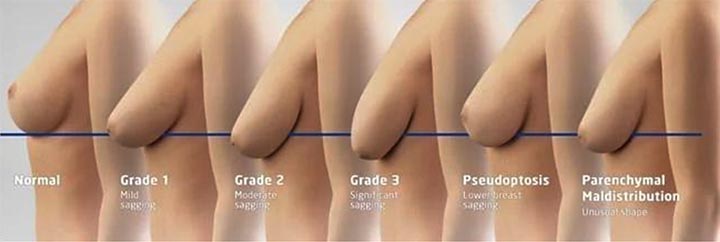
- Breasts that are pendulous but of sufficient size
- Breasts that are devoid of substance or firmness.
- Nipples and areolas point downward, particularly if located below the breast crease.
- Breasts that appear different from one another; for example, one breast may appear firm and well-positioned while the other does not.
- Breasts that are not all the same size.
- Breasts that aren’t too big.
Large and heavy breasts can be lifted, but the outcomes may not last as long as a breast lift performed on smaller breasts; the weight of larger breasts works against surgical changes.
You have completed childbearing and breastfeeding. If you intend to have children, you should postpone cosmetic breast surgery. Pregnancy can stretch the breasts and reduce their volume, reducing the benefits of surgery.
You are most likely a good candidate for this procedure if you are in good general health, have a positive attitude, and realistic expectations.
Read – How to reduce Cankles | Areola Reduction Surgery
Breast Lift Price and Cost
As per 2019 statistical data from the American Society of Plastic Surgeons, the average cost of a breast lift is $4,693. This average cost is only a portion of the total cost; it does not include anesthesia, operating room facilities, or other related costs. To determine your ultimate fee, please contact your plastic surgeon’s desk.
The cost for breast lift surgery will be determined by the surgeon’s experience, the type of procedure used, and the geographic location of the office.
Most health insurance policies do not cover breast lift surgery or its consequences; however, many plastic surgeons offer patient financing plans; be sure to inquire.
The Final Cost of a Breast Lift May Include
- Fees for anesthesia
- Costs of a hospital or surgical facility
- Medical examinations
- Post-surgery clothing
- Medications
- Fee for a surgeon
Risks of Breast Lift
A breast lift carries a number of risks, including:
- While scars are irreversible, they will soften and fade over the course of one to two years. Bras and bathing suits can generally conceal scars from a breast lift. Scars could become thick and wide due to poor healing in rare cases.
- Changes in the touch or deep sensation of the nipple or breast. Whereas sensation usually returns within a few weeks, some loss of sensation may be long-lasting. Erotic sensation is usually unaffected.
- Asymmetrical or quite irregular shape and size of the breasts. This could happen as a result of changes that occur during the healing process. Furthermore, surgery may not be able to correct pre-existing asymmetry.
- The nipples or areolae may be lost in part or entirely. Occasionally, the blood circulation to the nipple or areola is cut off during a breast lift. This can cause damage to the breast tissue in the area, resulting in the partial or total loss of the nipple or areola.
- Breast-feeding is sometimes challenging. While breastfeeding is usually possible after a breast lift, some women may struggle to produce enough milk.
A breast lift, like any major surgery, carries the risk of bleeding, infection, and an inflammatory response to anesthesia. An allergic reaction to the surgical tape or other materials used during or after the operation is also possible.
Read Laser Hair Removal Procedure | Butt Implants
Consultation
You’ll first consult with a plastic surgeon about a breast lift. Throughout your initial consultation, your plastic surgeon will most likely:
Examine your medical history. Prepare to respond to questions about your current and previous medical conditions. If you have a family history of breast cancer, tell your doctor.
Please share the outcomes of any mammograms or breast biopsies. Discuss any medications you’re taking or have recently taken, as well as any surgeries you’ve had.
Perform a physical examination. The doctor will examine your breasts, including the position of your nipples and areolae, to determine your treatment options.
He or she will also take into account the quality of your skin tone. Breast skin with a good tone will help to keep the breasts in a better position after a breast lift. The doctor may also photograph your breasts for your health record.
Talk about your expectations. Discuss why you want a breast lift and what you hope to achieve in terms of appearance afterward. Make sure you are aware of the risks and rewards, such as scarring and adjustments in nipple or breast sensation.
Ensure Some Points
- Are the surgeon certified by the American Board of Plastic Surgery?
- Were the surgeon trained specifically in the field of plastic surgery?
- The duration of plastic surgery training has he/she had?
- Does the surgeon have hospital privileges to perform breast lift surgery? If so, at which hospitals specifically?
- Are you a good and safe candidate for this procedure?
- Is the chamber-based operation theater accredited by a nationally- or state-recognized accrediting agency, or is it state-licensed or Medicare-certified?
- Where and how will they perform your procedure?
- What surgical technique is best for yourself specifically?
- The duration of the recovery period, and what kind of nursing will you need during your recovery period?
- What are the risks and complications associated with this surgical procedure?
- The ability to breastfeed after the surgery?
- How can you expect my lifted breasts to look over time? After pregnancy? After breastfeeding? Make sure you have the answer to both questions.
- What are your options if you are quite dissatisfied with the cosmetic result of your lifted breasts?
- Do you have before-and-after photos that you can look at for this procedure and what results are reasonable for yourself? You may don’t find these photos because some hospitals don’t share these photos as they are confidential.
Read – Hip Dips
Preparation for a Breast Lift Surgery
- Make an appointment for a mammogram. Your doctor may advise you to have a baseline mammogram before the surgery and another one a few months later. This will assist your doctor in detecting changes in your breast tissue and interpreting future mammograms.
- Quit smoking. Smoking reduces blood flow to the skin and can sluggish healing. If you smoke, your doctor will advise you to quit before surgery.
- Certain medications should be avoided. Aspirin, anti-inflammatory drugs, and herbal supplements, all of which can cause bleeding, should be avoided.
- Make arrangements for assistance during your recovery. Make arrangements for somebody to drive you back to the house after surgery and to accompany you as you recover. Throughout your initial recovery, you may require assistance with daily activities such as washing your hair.
- Maintain a healthy weight. If you’ve gained weight in the last year, consider making lifestyle changes or starting an exercise program to help you lose weight.
Read Buccal Fat Removal Procedure
The procedure of the Breast Lift Surgery
A mastopexy is performed on patients under general anesthesia or intravenous sedation in a hospital, freestanding surgical center, or surgeon’s office that has a surgical suite. The position of the incisions and resulting scars are determined by the technique used to remove breast skin and reshape the breast. Your surgeon will choose a technique on your breast size and shape, areola size and place, degree of breast sagging, skin quality and elasticity, and excess skin.
- The plastic surgeon will remove excess breast skin(which was forcing the breast downward) and elevate the nipple and areola.
- If your areola has become stretched, surgeons will shrink it.
- To reshape the breast perfectly, skin that was previously located above the areola is brought down and together beneath the breast.
- Your surgeon removes excess skin and close the incisions, tightening the skin, sewing the breast back together, and placing sutures deep in the breast tissue to support the new breast position for a longer time.
- Scars are typically hidden beneath the breasts, with some light scarring visible on top of the breast.
- The nipples and areolas stay attached to underlying piles of tissue, which usually allows for sensation and the capacity to breastfeed to be preserved.
There is some modified technique that prevents horizontal incision beneath the breast.
Your plastic surgeon will discuss this with you if you are a good candidate for a modified technique.
Some basic steps
Some basic procedures are being followed by surgeons during almost every surgery. Don’t be scared, know some of these steps for being prepared.
- During the surgery, you will be given medications to help you relax.
- Although general anesthesia is generally used during your breast lift procedure, local anesthesia or intravenous sedation may be preferred in some cases.
- Various monitors would be used to check your heart, blood pressure, pulse, and the concentration of oxygen circulating in your blood during the surgical procedure for your safe operation.
- Your surgeon will adhere to the surgical plan that you and your surgeon agreed upon prior to surgery.
- Once the procedure has begun, the surgeon may make the decision to combine different techniques or change a technique in order to achieve the best possible result. It is critical that you are at ease and trust your doctor to make these decisions.
- Following the surgery, you will be wrapped in a bulky gauze dressing (bandage) around your breasts and chest, or you may be required to wear a surgical bra. Your breasts may be fitted with drainage tubes.
- You will be taken to a recovery area where you’ll be closely monitored for the remainder of your stay.
- You (or someone looking after you) should have been able to empty and reset the drains before leaving for home.
Fat Transfer Breast Augmentation
Recovery and Post Operation Care
Your breasts will most likely be wrapped with gauze and a surgical support bra after a breast lift. To drain any excess blood or fluid, small tubes may be placed at the incision sites in your breasts.
Just After The Breast Lift Surgery
In general, you can assume to be bandaged, to wear compression garments, and to have surgical drains.
You may feel some pain and discomfort after the anesthesia wears off. Speak to your doctor if the pain is severe or long-lasting. You will also experience some redness and swelling following the surgery.
Contact your surgeon to determine whether your pain, redness, and swelling are reasonable or indicative of a problem.
Bruising, loss of feeling or changes in nipple sensitivity, itching all over incision sites, and enhanced firmness or fullness in the breast tissue are also common recovery adverse effects of mastopexy. These side effects should fade over the next few weeks, with some lasting up to three months after the surgery.
Read B Cup Breasts
Recovery Time
It is very important that you follow all of your surgeon’s patient care guidelines. This will include information on how to wear compression garments, how to care for your drains, how to take an antibiotic if prescribed, and what level and type of activity are safe. Your surgeon will also go over the normal symptoms you’ll be experiencing as well as any potential signs of abnormalities. It is critical to understand that the amount of time required for recovery varies greatly between individuals.
First Week of Recovery
- You surely can get out of bed for short periods of time the day after surgery.
- After a few days, you should be able to move around more freely.
- Avoid straining, bending, and lifting(heavy or light both) because these activities can cause swelling or even bleeding.
- To prevent putting pressure on your breasts, you will most likely be instructed to sleep on your back.
- The surgical drains will be removed within a few days of the surgery, and your dressings most likely to be changed or removed at the same time.
- Your chest may feel stiff and sore during this time.
Two – Six Weeks of Recovery
- Depending on your employment, you should be able to return to work within a week or so after breast lift surgery.
- Too much physical activity should be avoided for at least the first two weeks after surgery. After that, for at least the next month, be extremely gentle with your breasts.
- Avoid sexual activity for at least one week, but your plastic surgeon may recommend you to wait even longer. After that, for at least the next couple of weeks, be extremely gentle with your breasts.
- Wearing a support bra for a few weeks until the swelling and discoloration of your breasts subsides may be advised.
- Stitches are typically removed in stages over a three-week period, starting about one week after surgery.
- You may realize that the nipple and areola areas have less sensation. This is usually only short-term; however, it can take weeks, months, or even a year before the sensation goes back to normal.
- It may take some time for your breasts to take on a more natural appearance.
- Initially, the incisions will be somewhere between red and pink. They will remain this way for several months after surgery.
- After a few weeks, you should be able to resume most of your normal activities, including some light exercise.
- During this time, you may continue to feel mild, intermittent discomfort, but this is normal. Inform your doctor if you are experiencing severe pain.
The Result of Breast Lift
- Your breasts will look different right away, though their shape will continue to change and settle over the next few months.
- First few days scars will look red and lumpy. While scars are permanent, they will soften and become thin and white over the course of one to two years. Bras and bathing suits can generally conceal scars from a breast lift.
- Even if you did not have a breast reduction in conjunction with the procedure, you may notice that your bra size is a little thinner after a breast lift. This is simply due to your breasts being more and more firmer and rounder over time.
Lasting of the Result
If a breast lift is done correctly, your breasts should not droop again for decades, supposing you don’t have significant weight disturbances or go through pregnancy. Although some settling may occur, the new nipple position should be preserved. Inquire with your surgeon about the procedure that will be used. Aesthetic surgeons typically do not rely on a simple skin lift; instead, they sculpt the entire breast tissue, resulting in a longer-lasting lift.
Breast Lift Without Implants
You can have a breast lift without having breast implants. A breast lift, in actuality, is intended to remove excess skin, raise and/or readjust the nipple-areolar complex, and reshape native surrounding tissue in a manner similar to a small implant in those who do not want implants. The majority of surgeons perform “volume-preserving” breast lifts, which means they keep as much breast volume as possible while focusing on repositioning the breasts on the chest wall. Many traditional breast lift techniques resulted in a flattened look, making the breasts smaller and with or little no shape. The medial pedicle technique used by surgeons helps to avoid this for the best possible outcome.
It is important to note, however, that patients who want to significantly increase the size of their breasts in addition to getting them lifted will frequently be advised to undergo an augmentation mastopexy. This process, also known as a breast lift with implants, can eliminate excess breast skin and tissues to reduce sagging while also assisting qualified patients in achieving a fuller shape, improved firmness, and increased breast volume.
Finally, for the right people, a breast lift with or without implants can produce exceptional, natural-looking results, and the best option for your aesthetic concerns and wishes can be chosen during a consultation with a board-certified plastic surgeon.
Breast Lift Before and After Images
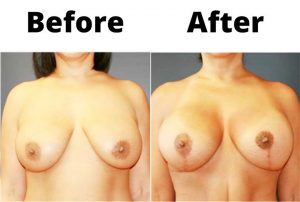
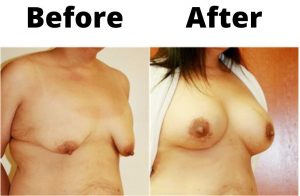
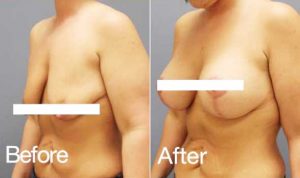
Breast Lift Summary
A breast lift is a surgical procedure in which your nipple is repositioned higher on your chest wall by a surgeon. They also tighten the surrounding tissue and eliminate any excess skin.
If you’re thinking about getting a surgical breast lift, one test is to stick a pencil under your breast and see if it remained there. If so, a breast lift may be a choice.
If you are bothered by the looks or feel of droopy, flat, or enlarged breasts, you may wish to have this procedure performed.
Last Updated on February 23, 2022 by Learn From Doctor Team




